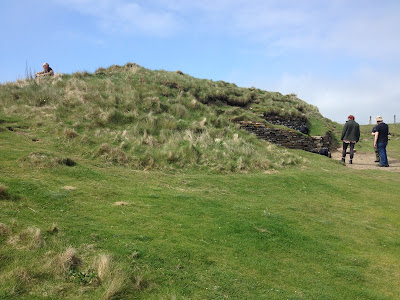The Tomb of the Eagles is a Neolithic
chambered cairn in Isbister in South Ronaldsay, the southern-most island of
Orkney. Unlike most tombs in Orkney, which were either emptied prior to their
closure in ancient times or have been destroyed thanks to time, treasure-hunters
or clumsy antiquarians, the Tomb of the Eagles survived intact until its
careful excavation in the late 20th century, through which our knowledge
of Neolithic Orkney has surged.
The tomb was built around 3150BC, and
comprises a stone-built and grass-covered mound which covers a central chamber
accessed by a low passage, three metres long, through which visitors have to
crawl on their hands and knees. The main chamber contained bodies which were
largely intact, perhaps after their excarnation (devouring by carrion-eaters)
but before they were deposited with the rest of the ‘ancestors’. It seems the
process of death was a long-drawn-out affair in Neolithic Orkney. Side chambers
contained unarticulated bones, largely sorted into groups of skulls and other
bones. The tomb contained at least 340 people, including men, women, children
and babies.
Around 2500BC, the time when bronze
started to filter into Britain, the social structure in Orkney collapsed. The
tombs which had been used for nearly a thousand years, along with other ritual
buildings such as at the Ness of Brodgar, were carefully dismantled or sealed and
never used again. The passage of the Isbister cairn was blocked from the inside
and the entire tomb was filled with rubble, soil and ancient human bones, perhaps
those kept as relics in houses. It was never entered again, although many
Bronze Age burial cists nearby indicate the remembered sanctity of the site.
Skulls and round-bottomed Unstan Ware
pottery deposited in a side chamber.
Each of the dozens of tombs in Orkney
was likely linked to an individual settlement or community, and each seems to have
been close-knit and independent. Studies of the skeletons show a high incidence
of genetic abnormalities which suggests a large degree of in-breeding. Other Orkney
tombs show a different range of abnormalities.
Many are linked to specific and often
unique animals or birds which may have totemic links. The Isbister cairn is
uniquely associated with sea eagles, which were once common on the high cliffs
of the area. Like many of the potential ‘totems’, sea eagles are carrion-eaters
and were plausibly used to devour the bodies of the deceased before their
interment in the tomb.
Like many Orkney tombs, Isbister
opens out across the sea, but the unusual thirty-metre sheer drop is
reminiscent of the soaring spirit of the sea eagle.
A foundation deposit sealed under the
flagstone floor comprised bones of humans and sea eagles, dating to 3150BC, and
eagle talons were placed with many of the bodies. One had fifteen talons which
perhaps formed a necklace. Perhaps eagle-catching was a test of status for the
people of Isbister. Scaling the precipitous and sea-lashed cliffs to reach
their nesting sites would certainly have tested the physical and mental
strength of anybody.
Nearly a thousand years after the
tomb was sealed, in 1500BC, a cist grave was inserted in the mound, and this
also contained sea eagle bones along with the human remains. Orkney’s status
and way of life had changed immensely since the beginning of the Bronze Age,
but it seems the people of Isbister had not forgotten their ancient heritage.
White-tailed sea eagle. Jacob Spinks,
Wikicommons.





No comments:
Post a Comment